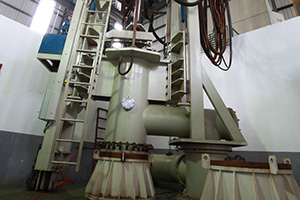VAR vacuum arc remelting (marketing department of Shanghai HY Industry Co., Ltd)
Vacuum arc remelting is a vacuum smelting technology that uses an arc as a heat source to smelt metals under vacuum conditions, abbreviated as VAR. It includes vacuum arc double electrode remelting and vacuum condensing furnace melting. Smelting under vacuum not only eliminates the contamination of steel and alloys by outside air, but also reduces the gas and low-melting point harmful metal impurities in steel and alloys, and improves the purity of remelted metals. The VAR process can effectively reduce metal The content of hydrogen, lead, bismuth, silver, etc., and has a certain denitrification ability.
The principle of vacuum arc remelting is: under slag-free and vacuum conditions, the metal electrode is rapidly melted under the high temperature of the DC arc and re-solidified in a water-cooled copper mold. When the liquid metal forms molten droplets in the form of thin layers and passes through the arc area of nearly 5000K and transitions into the crystallizer, as well as in the process of maintaining and solidifying in the crystallizer, a series of physical and chemical reactions occur, so that the metal is refined, so as to achieve purification of the metal. , The purpose of improving the crystal structure and improving the performance. Therefore, the essence of the vacuum arc remelting method is to use the heat energy of the DC arc to re-melt the metal consumable electrode of known chemical composition under vacuum and solidify it into an ingot in a water-cooled copper mold to improve its quality. .
The metallurgical characteristics of vacuum arc remelting can be summarized into 10 items:
-
Smelting under vacuum not only prevents the contamination of steel and alloys by outside air, but also reduces the gas and low melting point harmful metal impurities in steel and alloys, improves the purity of remelted metals, and the VAR process can effectively It can greatly reduce the content of hydrogen, lead, bismuth, silver, etc. in the metal, and has a certain denitrification ability.
-
Due to the low oxygen partial pressure in the smelting chamber, the active elements such as aluminum and titanium are less burned during the remelting process, and the chemical composition control of the alloy is relatively stable, but the volatile elements such as magnesium and manganese have certain burning losses.
-
Due to the use of vacuum and slag-free operation and remelting in a water-cooled copper mold, active metal ingots can be smelted. Vacuum arc remelting is the main smelting method for smelting titanium and titanium alloys.
-
The arc zone temperature is high, which can remelt refractory metals and their alloys.
-
Since the smelting is carried out in an environment without slag, refractory materials and molten metal, the contamination of the alloy by external inclusions is eliminated or reduced; in addition, the molten metal flows from the bottom to the bottom during the vacuum arc remelting process. The sequential solidification and rapid cooling above can remove non-metallic inclusions to a certain extent and make the size of the regenerated inclusions small and evenly distributed during the solidification process, and the purity of the remelted metal in terms of non-metallic inclusions is high.
-
By reasonably controlling the solidification and crystallization process of the alloy, the solidification structure of the alloy can be improved, and a high-quality ingot with low segregation degree and high density can be obtained.
-
A reasonable capping process system can make the shrinkage cavity of the head of the spindle smaller, and the crystalline structure of the “V”-shaped shrinkage area is more consistent with the body of the spindle, thereby improving the yield of the spindle.
-
Due to the splash of molten metal in the arc area during the remelting process, the surface of the remelting ingot is rough and porous, and the content of inclusions and volatile elements is high. The surface of the remelting ingot needs to be peeled before hot processing.
-
There is no desulfurization method in the remelting process, so the sulfur content of the consumable electrode is required to be low.
-
During the vacuum arc remelting process, the atmosphere and the pressure of the melting chamber are controllable.


